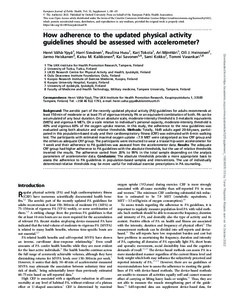How adherence to the updated physical activity guidelines should be assessed with accelerometer?
Kokko Sami; Heiskanen Jarmo; Savonen Kai; Vähä-Ypyä Henri; Kaikkonen Kaisu M.; Heinonen Olli J.; Husu Pauliina; Sievänen Harri; Mänttäri Ari; Vasankari Tommi; Tokola Kari
https://urn.fi/URN:NBN:fi-fe2022102463137
Tiivistelmä
Background
The aerobic part of the recently updated physical activity (PA) guidelines for adults recommends at least 150 min of moderate or at least 75 of vigorous-intensity PA or an equivalent combination of both. PA can be accumulated of any bout duration. On an absolute scale, moderate-intensity threshold is 3 metabolic equivalents (METs) and vigorous 6 METs. On a scale relative to individual’s personal capacity, moderate-intensity threshold is 40% and vigorous 60% of the oxygen uptake reserve. In this study, the adherence to the new guidelines was evaluated using both absolute and relative thresholds.
Methods
Totally, 1645 adults aged 20–64 years, participated in this population-based study and their cardiorespiratory fitness (CRF) was estimated with 6-min walking test. The participants with estimated maximal oxygen uptake <7.9 MET were categorized as low CRF group and the others as adequate CRF group. The participants were instructed to wear a triaxial hip-worn accelerometer for 1 week and their adherence to PA guidelines was assessed from the accelerometer data.
Results
The adequate CRF group had higher adherence to PA guidelines with the absolute thresholds, but the use of relative thresholds inverted the results. The adherence varied from 20% to 99% in the total sample depending on the analysis parameters of accelerometer data.
Conclusions
The absolute thresholds provide a more appropriate basis to assess the adherence to PA guidelines in population-based samples and interventions. The use of individually determined relative thresholds may be more useful for individual exercise prescriptions in PA counseling.
Kokoelmat
- Rinnakkaistallenteet [19204]
